

BOM_technique. Accords 23. When to Play Harmonic Minor - 5 Approaches. Arpeggio Shapes 2. UNE MÉTHODE D' HARMONIE de base pour la Guitare. Guitar Chord Progressions - Turn Chords Into Songs. Home> Progressions Welcome.
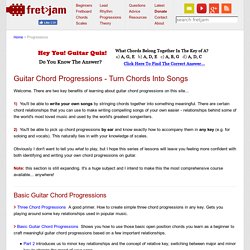
There are two key benefits of learning about guitar chord progressions on this site... 1) You'll be able to write your own songs by stringing chords together into something meaningful. There are certain chord relationships that you can use to make writing compelling songs of your own easier - relationships behind some of the world's most loved music and used by the world's greatest songwriters. 2) You'll be able to pick up chord progressions by ear and know exactly how to accompany them in any key (e.g. for soloing and vocals).
Playing Scales Across The Fretboard Fast, Fluidly & Musically. Home> Scales / Lead > Scales Across The Neck If you've spent any time learning guitar scales, you'll know the importance of memorizing patterns - the roadmap for playing scales across the fretboard.

While you may be familiar with "boxed" and "three notes per string" scale patterns, you soon feel the urge to break out of these narrow limitations and span more of the neck. Major Scale Patterns - 3 Notes Per String & More. Home> Scales> Major Scale Patterns This lesson follows on logically from the major scale positions lesson, which gave us the patterns we needed to visualise the major scale across the entire fretboard, in simple steps.
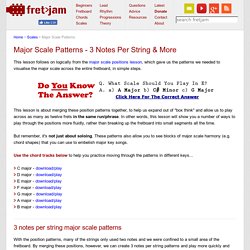
This lesson is about merging these position patterns together, to help us expand out of "box think" and allow us to play across as many as twelve frets in the same run/phrase. In other words, this lesson will show you a number of ways to play through the positions more fluidly, rather than breaking up the fretboard into small segments all the time. But remember, it's not just about soloing. These patterns also allow you to see blocks of major scale harmony (e.g. chord shapes) that you can use to embelish major key songs. Melodic minor. Google Image Result for. Google Image Result for. Playing Scales Across The Fretboard Fast, Fluidly & Musically.
Constructing Solos On A Guitar. Index Of All Articles by Tim Gillespie Soloing is like learning to talk.

Knowing the words in not enough. You have to be able to form phrases in the key and then transform them into statements. There is no time to read music notation or learn where the notes are when forming a solo. There is nothing like it and nothing can make up for it. Buy The Book Now. Constructing Solos On A Guitar. The Uncle Tim Newsletter. Articles and opinions about the music industry and learning to play guitar. Constructing Solos On A Guitar. Constructing Solos On A Guitar. Pinterest. Accords mineurs - La guitare jazz. Google Image Result for. Synaptic Studios — Scales: The G Major Scale Harmonized. The block below consists of chords moving up the fretboard.
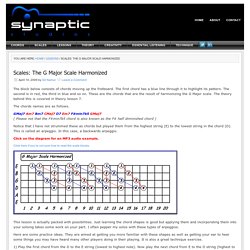
The first chord has a blue line through it to highlight its pattern. The second is in red, the third in blue and so on. Le Guide pour improviser avec les arpèges et rendre vos solos mélodiques. Bienvenue sur Maîtriser-la-Guitare.com !
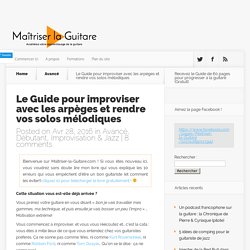
Rocktron RFS2 Double Latched Footswitch. Scale and Arpeggio Resources: A Guitar Encyclopedia : Rich Cochrane. Guitarworld. Google Image Result for. Accord majeurs 69. LittleWing with sound. Répétitions : mode d'emploi. LeechBlock. Apprendre la guitare et la musique avec des logiciels éducatifs. Télécharger Transcribe! pour Windows : téléchargement gratuit ! Repiquer un morceau avec Audacity. Sourceforge. Outils et techniques pour transcrire vos plans favoris à la guitare. La somme d’informations disponibles sur la toile est gigantesque et elle en donnerait presque le tournis.
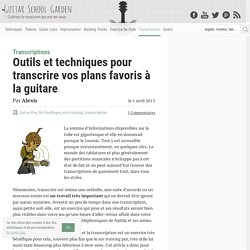
Tout y est accessible presque instantanément, en quelques clics. Le monde des tablatures et plus généralement des partitions musicales n’échappe pas à cet état de fait et on peut aujourd’hui trouver des transcriptions de quasiment tout, dans tous les styles. Néanmoins, transcrire soi-même une mélodie, une suite d’accords ou un morceau entier est un travail très important qui ne devrait être ignoré par aucun musicien. Investir un peu de temps dans une transcription, aussi petite soit-elle, est un exercice qui paye et ses résultats seront bien plus visibles dans votre jeu qu’une heure d’aller-retour affalé dans votre canapé en regardant les péripéties téléphoniques de Nabila et ses amies.
Voici donc le plan qui va nous servir tout au long de ce billet, tiré du morceau Zing Zing : Apprendre à l'oreille ? LiSTE pr débuter. Pédagogie. Commençons par des documents vierges qui pourraient vous être utiles...

Gammes10.jpg. Accord mineurs 6. Django ! - Page 1. Salut les Gretscheux(ses)C'est fou comme « jouer gitan » semble difficile.

C'est sûr c'est dur mais parfaitement réalisable. La première chose à apprendre ce sont les accords gitans. Ils sont un petit peu différents des accords courants du jazz mais assez facile à assimiler. Sur ce site, ils sont bien détaillés : il faut comprendre que les thèmes manouches sont des standards à apprendre par cœur. Je ne sais pas ce qu'en pense le Colonel mais je les trouve plus simples à jouer que certains standards classiques comme Blues rondo à la turc ou le terrible West coast blues de Wes Montgomery.Enfin il y a les chorus.
Accueil. Synaptic Studios — Finger Picking: Comping to a walking bass line. This lesson will show you how to play a walking bass line accompanied by little chords.

This is a 12 bar blues progression in Bb with a swing feel to it. To play this, you will use your thumb (P) to play the bass line and your index (I) and middle (M) fingers to pluck the chords. Work on this slowly. Once you have learned it, work on speed and also try to interpret it differently. The fingerings indicated above and below the tab represents how I feel most comfortable playing this progression. TIP: Whenever you see 2 notes together in this progression, like the 6 and 7 on top of each other in the first bar, think of those notes plus the note just before it as a chord. Click on the diagram for an MP3 audio example. Synaptic Studios — Quick reference to all the chords at Synaptic Studios. This page is a quick reference to all the chords at this site. Click here if you’re not sure how to read the chord blocks. Basic Open Chords Click on the diagrams for an MP3 audio example. Synaptic Studios — A Great Guitar Exercise. Synaptic Studios — Scales: The A Major Scale Harmonized 3rd and 5th degrees.
These are highly recognizable sounds often heard in rock and country playing but used also in all forms of music. The block below consists of chords moving up the fretboard. The first chord has a red line through it to highlight its pattern. The second is in blue, the third in red and so on. These are the chords that are the result of harmonizing the A Major scale 3rd and 5th notes. The theory behind scale harmonization is covered in theory lesson 7. Synaptic Studios — Scales: The D Major Scale Harmonized 3rd and 5th degrees.
Synaptic Studios — Scales: Exercises 123 234 345. This exercise is aimed at improving your technique and offering you extended scale phrasings. The basic idea in this exercise is to play the first 3 notes in the scale, then, starting at the second note in the scale play 3 more, then, starting from the 3rd note in the scale play 3 more etc. If the scale was numbers, the pattern would be: 123 234 345 456 567 678 789 etc Remember that these exercises can be played anywhere on the neck using any scale. The examples below use the A Minor Pentatonic scale ( 3rd position ) and the G Major scale ( 1st position ). When practicing any exercise, always start off slowly. Click on the tableture for an MP3 audio example. Synaptic Studios — Scales: The G Major Scale Harmonized.
Apprendre à improviser à la guitare avec Le Cercle de l'Harmonie.